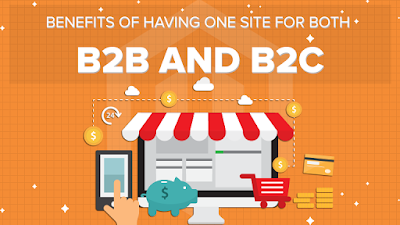Today’s trend involves enterprises selling to consumers as well as other enterprises to ramp up their sales volume and boost respective market share. Businesses that either manufacture a particular product or trade in big volumes can leverage economies of scale thus realizing large margins by direct selling to the customer instead of selling to other businesses which involves giving a bulk discount.
A good example of selling to both enterprises and individual customers is the manufacturer. Most of the time the latter cannot sell sufficient items directly to individual customers and have to depend on sales made through the B2B route. Many entities want to eliminate the middleman by going down the direct to customer sales route and making much more profit than before.
Usually, several businesses have separate sites for B2B and B2C sales. There are two reasons for this policy. Firstly, the nature and market for the 2 sales modes are quite different. The second reason is that this practice makes operations relatively simple.
We look at the advantages of having a single unified site for both B2B and B2C.
- All products for sale are listed at one place
Businesses can manage all products at a time as they are stored in a single database. There are no complications that arise when simultaneously managing multiple catalogues.
- Easier to cross sell
As information of both type of customers are available enterprises can cross-sell with much more ease than when B2B and B2C sites are different.
- Ramps up SEO ranking
A single site is easier to work on than 2 sites from a SEO’s perspective. Having 2 sites may also confuse site visitors.
- Reduces the technical burden
As there is only a single theme as well code base to handle the technical load is less. From the technical perspective resources such as time, money and effort are saved when there is a single site instead of two.
- Offer a better experience to B2B purchasers
In a single site, B2B buyers can search, get information regarding the product and purchase swiftly on the lines of individual customers. Time is not wasted in commuting to a store or having telephonic conversations.
- Simplifies the marketing aspect
If an enterprise has a single site as well as brand customers will find it easier to recognize the company. It is observed that often folk get confused with the brand names which results in purchasing the incorrect item. A single brand simplifies all the marketing and promotional effort.
- Brings down expenses
By just having one website there will be less requirement of staff as well as infrastructure. The selling model is optimal as both individual customers and organizations are catered to.
- Ease of integration
By having a single website only one entity has to be integrated with important systems such as CRM, ERP and others. All systems will work from one place and there is no necessity of separate integrations.
The trend of a single site for both modes of ecommerce Website business is likely to soar in the near future with entities such as Amazon already adopting it.

Comments
Post a Comment